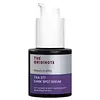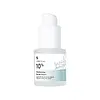What's inside
What's inside
 Key Ingredients
Key Ingredients

 Benefits
Benefits

 Concerns
Concerns

No concerns
 Ingredients Side-by-side
Ingredients Side-by-side

Water
Skin ConditioningGlycerin
HumectantButylene Glycol
HumectantTranexamic Acid
AstringentNiacinamide
SmoothingRosa Damascena Flower Water
MaskingCyclopentasiloxane
EmollientGlycereth-26
HumectantHydroxyacetophenone
Antioxidant1,2-Hexanediol
Skin ConditioningPEG/PPG-17/6 Copolymer
SolventAmmonium Acryloyldimethyltaurate/Vp Copolymer
Methylpropanediol
SolventMethicone
EmollientPhenylethyl Resorcinol
AntioxidantGlycyrrhiza Uralensis Root Extract
Skin ConditioningAllantoin
Skin ConditioningTremella Fuciformis Polysaccharide
Emulsion StabilisingPortulaca Oleracea Flower/Leaf/Stem Extract
AntioxidantPaeonia Lactiflora Extract
AstringentGlyceryl Glucoside
HumectantPolysorbate 80
EmulsifyingPropylene Glycol
HumectantBisabolol
MaskingOsmanthus Fragrans Flower Extract
MaskingStephania Tetrandra Root Extract
Skin ConditioningBeta-Glucan
Skin ConditioningCaprylic/Capric Triglyceride
MaskingPhenoxyethanol
PreservativePhospholipids
Skin ConditioningHydrogenated Lecithin
EmulsifyingDaucus Carota Sativa Root Extract
Skin ConditioningCeramide NP
Skin ConditioningGlutathione
Panax Ginseng Root Extract
EmollientTocopheryl Acetate
AntioxidantWater, Glycerin, Butylene Glycol, Tranexamic Acid, Niacinamide, Rosa Damascena Flower Water, Cyclopentasiloxane, Glycereth-26, Hydroxyacetophenone, 1,2-Hexanediol, PEG/PPG-17/6 Copolymer, Ammonium Acryloyldimethyltaurate/Vp Copolymer, Methylpropanediol, Methicone, Phenylethyl Resorcinol, Glycyrrhiza Uralensis Root Extract, Allantoin, Tremella Fuciformis Polysaccharide, Portulaca Oleracea Flower/Leaf/Stem Extract, Paeonia Lactiflora Extract, Glyceryl Glucoside, Polysorbate 80, Propylene Glycol, Bisabolol, Osmanthus Fragrans Flower Extract, Stephania Tetrandra Root Extract, Beta-Glucan, Caprylic/Capric Triglyceride, Phenoxyethanol, Phospholipids, Hydrogenated Lecithin, Daucus Carota Sativa Root Extract, Ceramide NP, Glutathione, Panax Ginseng Root Extract, Tocopheryl Acetate
Rosa Damascena Flower Water 48%
MaskingGlycerin
HumectantNiacinamide 10%
SmoothingWater
Skin ConditioningMethylpropanediol
SolventSodium PCA
HumectantBetaine
HumectantZinc PCA
HumectantAmmonium Acryloyldimethyltaurate/Vp Copolymer
Butylene Glycol
HumectantSodium Lauroyl Lactylate
EmulsifyingPentylene Glycol
Skin ConditioningXanthan Gum
EmulsifyingAdenosine
Skin ConditioningOctanediol
Ethylhexylglycerin
Skin ConditioningCeramide NP
Skin ConditioningHydrolyzed Algae Extract
Skin ConditioningAnthemis Nobilis Flower Extract
MaskingCeramide AP
Skin ConditioningPhytosphingosine
Skin ConditioningCholesterol
EmollientCarbomer
Emulsion StabilisingBeta Vulgaris Root Extract
Skin ConditioningAllantoin
Skin ConditioningCaffeine
Skin ConditioningCeramide EOP
Skin ConditioningTocopherol
Antioxidant1,2-Hexanediol
Skin ConditioningRosa Damascena Flower Water 48%, Glycerin, Niacinamide 10%, Water, Methylpropanediol, Sodium PCA, Betaine, Zinc PCA, Ammonium Acryloyldimethyltaurate/Vp Copolymer, Butylene Glycol, Sodium Lauroyl Lactylate, Pentylene Glycol, Xanthan Gum, Adenosine, Octanediol, Ethylhexylglycerin, Ceramide NP, Hydrolyzed Algae Extract, Anthemis Nobilis Flower Extract, Ceramide AP, Phytosphingosine, Cholesterol, Carbomer, Beta Vulgaris Root Extract, Allantoin, Caffeine, Ceramide EOP, Tocopherol, 1,2-Hexanediol
 Reviews
Reviews

Ingredients Explained
These ingredients are found in both products.
Ingredients higher up in an ingredient list are typically present in a larger amount.
1,2-Hexanediol is a synthetic liquid and another multi-functional powerhouse.
It is a:
- Humectant, drawing moisture into the skin
- Emollient, helping to soften skin
- Solvent, dispersing and stabilizing formulas
- Preservative booster, enhancing the antimicrobial activity of other preservatives
Allantoin is a soothing ingredient known for its protective and moisturizingg properties. Because of this, it is often added to products with strong active ingredients.
Studies show higher concentrations of this ingredient can promote wound healing.
Though it can be derived from the comfrey plant, allantoin is produced synthetically for cosmetic products to ensure purity.
Learn more about AllantoinAmmonium Acryloyldimethyltaurate/Vp Copolymer (let's call it AAVC for short) is a synthetically created polymer. It's used as a film-forming agent and used to thicken the consistency of products.
AAVC is able to increase the consistency and viscosity of products due to its large molecule size. It also prevents ingredients from separating.
Butylene Glycol (or BG) is used within cosmetic products for a few different reasons:
Overall, Butylene Glycol is a safe and well-rounded ingredient that works well with other ingredients.
Though this ingredient works well with most skin types, some people with sensitive skin may experience a reaction such as allergic rashes, closed comedones, or itchiness.
Learn more about Butylene GlycolCeramide NP is a type of ceramide.
Ceramides are intercellular lipids naturally found in our skin that bonds dead skin cells together to create a barrier. They are known for their ability to hold water and thus are a great ingredient for dry skin.
Ceramides are an important building block for our skin barrier. A stronger barrier helps the skin look more firm and hydrated. By bolstering the skin ceramides act as a barrier against irritating ingredients. This can help with inflammation as well.
If you would like to eat ceramides, sweet potatoes contain a small amount.
Read more about other common types of ceramides here:
Ceramide AP
Ceramide EOP
Glycerin is already naturally found in your skin. It helps moisturize and protect your skin.
A study from 2016 found glycerin to be more effective as a humectant than AHAs and hyaluronic acid.
As a humectant, it helps the skin stay hydrated by pulling moisture to your skin. The low molecular weight of glycerin allows it to pull moisture into the deeper layers of your skin.
Hydrated skin improves your skin barrier; Your skin barrier helps protect against irritants and bacteria.
Glycerin has also been found to have antimicrobial and antiviral properties. Due to these properties, glycerin is often used in wound and burn treatments.
In cosmetics, glycerin is usually derived from plants such as soybean or palm. However, it can also be sourced from animals, such as tallow or animal fat.
This ingredient is organic, colorless, odorless, and non-toxic.
Glycerin is the name for this ingredient in American English. British English uses Glycerol/Glycerine.
Learn more about GlycerinMethylpropanediol is a synthetic solvent and humectant.
As a solvent, it helps dissolve other ingredients, helping to evenly distribute ingredients throughout the product. This ingredient has also been shown to have antimicrobial properties which makes it a preservative booster.
Methylpropanediol is able to add a bit of moisture to the skin. It also helps other ingredients be better absorbed into the skin, such as salicylic acid.
Learn more about MethylpropanediolNiacinamide is a multitasking form of vitamin B3 that strengthens the skin barrier, reduces pores and dark spots, regulates oil, and improves signs of aging.
And the best part? It's gentle and well-tolerated by most skin types, including sensitive and reactive skin.
You might have heard of "niacin flush", or the reddening of skin that causes itchiness. Niacinamide has not been found to cause this.
In very rare cases, some individuals may not be able to tolerate niacinamide at all or experience an allergic reaction to it.
If you are experiencing flaking, irritation, and dryness with this ingredient, be sure to double check all your products as this ingredient can be found in all categories of skincare.
When incorporating niacinamide into your routine, look out for concentration amounts. Typically, 5% niacinamide provides benefits such as fading dark spots. However, if you have sensitive skin, it is better to begin with a smaller concentration.
When you apply niacinamide to your skin, your body converts it into nicotinamide adenine dinucleotide (NAD). NAD is an essential coenzyme that is already found in your cells as "fuel" and powers countless biological processes.
In your skin, NAD helps repair cell damage, produce new healthy cells, support collagen production, strengthen the skin barrier, and fight environmental stressors (like UV and pollution).
Our natural NAD levels start to decline with age, leading to slower skin repair, visible aging, and a weaker skin barrier. By providing your skin niacinamide, you're recharging your skin's NAD levels. This leads to stronger, healthier, and younger looking skin.
Another name for vitamin B3 is nicotinamide. This vitamin is water-soluble and our bodies don't store it. We obtain Vitamin B3 from either food or skincare. Meat, fish, wheat, yeast, and leafy greens contain vitamin B3.
The type of niacinamide used in skincare is synthetically created.
Learn more about NiacinamideRosa Damascena Flower Water comes from the Damask rose. It is a dilluted version of the Rose Essential oil.
The Damask Roses' petals have antioxidant, antimicrobial, and fragrance compounds. Though antioxidants are great for soothing skin, the fragrance compounds can irritate it.
Water. It's the most common cosmetic ingredient of all. You'll usually see it at the top of ingredient lists, meaning that it makes up the largest part of the product.
So why is it so popular? Water most often acts as a solvent - this means that it helps dissolve other ingredients into the formulation.
You'll also recognize water as that liquid we all need to stay alive. If you see this, drink a glass of water. Stay hydrated!
Learn more about Water